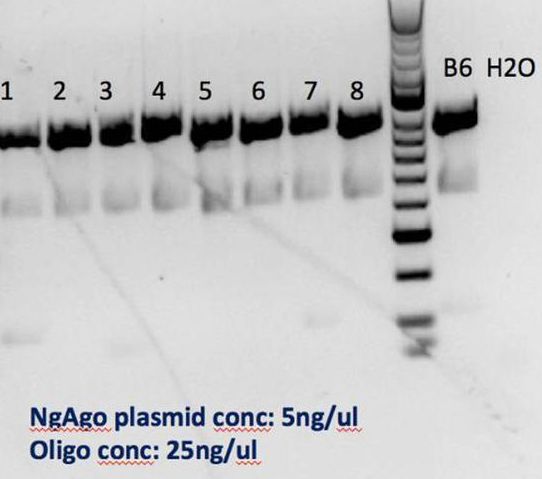韩春雨“NgAgo系统”实验步骤详细解读
2016-08-09 佚名 生物谷
A general protocol of NgAgo/gDNA-mediated genome editing1.Cell culture293T cells are maintained in high-glucose DMEM (Gibco) supplemented with 10% FBS (Gibco) and penicillin/streptomycin at 37°C w
A general protocol of NgAgo/gDNA-mediated genome editing

1.Cell culture
293T cells are maintained in high-glucose DMEM (Gibco) supplemented with 10% FBS (Gibco) and penicillin/streptomycin at 37°C with 5% CO2 incubation. When cells reach their ≈60% confluence, perform transfection. Before transfection, cells are changed to medium containing 2% FBS(heat inactivated). Since 293T cells are not firmly attached, be gentle and do not disturb cells when changing medium.
2.Transfection
2-1 NLS-NgAgo expressing plasmid is extracted with Wizard? Plus SV Minipreps DNA Purification System (Promega), and is adjusted to 100 ng/μl in water (pH 8.0, alkalization by NaOH).
2-2 5’ phosphorylated ssDNA guides are dissolved to 100 ng/μl in water (PH 8.0) For each well of a 24-well plate, 200-250 ng NLS-NgAgo expression plasmid and 100-300 ng guides are diluted in 50 μl Opti-MEM (Gibco); 1.25 μl Lipofectamine? 2000 is diluted in 50 μl Opti-MEM. Incubate the DNA mix and lipofectamine mix for 5 min.
2-3 Combine the DNA mix and lipofectamine mix with gentle pipetting and incubate for 20 min. The DNA/lipo mixture is then added into each well of cells.
*Since NgAgo follows “one-guide faithful” rule, i.e. guides can only be loaded when NgAgo protein is in the process of expression, to improve the efficiency of gDNA loading to NgAgo, sometimes multiple transfection of gDNA helps (e.g. depending on the different kinetics of NgAgo expression in different cells, a second transfection of gDNA can be performed 8, 12 or 24 hours after the primary transfection)
*As stated below, cells will be harvested 48-60 hours after transfection. 90% confluence of the cells on harvesting is ideal. Cell overplating significantly weakens the efficacy of genome editing. Taking HDR as an example, it occurs only during S and G2 phases.
3.Genomic DNA extraction
3-1 48-60 hours after transfection, cells are harvested by trypsin digestion. Four wells of cells are combined into a 1.5 ml EP tube.
3-2 For genomic DNA extraction, 500 μl of cell lysate buffer (50 mM Tris,100 mM EDTA,0.5% SDS,pH 8) and 10 μl proteinase K (10 mg/ml)are added into each tube and mixed gently and sufficiently. Bathe the tubes at 55℃ for 2 hours.
3-3 200 μl Tris-Phenol and 200 ul trichloromethane are added into each tube and mixed gently and sufficiently. After incubation for 5 min, samples are spun at 12,000 rpm for 15 min to separate aqueous phase from Phenol phase.
3-4 Carefully collect the aqueous phase into a clean EP tube.
3-5 Repeat the Steps 3-3 and 3-4 once and pool the aqueous phase.
3-6 Add 500 μl trichloromethane into the collected aqueous phase, mix gently and sufficiently, stay for 5 min, and then spin the sample at 12,000 rpm for 15 min to separate aqueous phase from Phenol phase. Carefully remove the aqueous phase into a clean EP tube.
3-7 Repeat the Steps 3-6 once.
3-8 Add 900 μl EtOH to the collected aqueous phase and incubate at -20°C for 30 min.
3-9 Centrifuge the sample at 12,000 rpm for 10 min, and then the DNA sediment is washed with 500 μl 75% EtOH thrice.
3-10 Air-dry the DNA sediment, add 50 μl 0.5 x TE and then adjust the genome DNA to 100 ng/μl for later use.
Note:
1.NgAgo/gDNA system is extremely sensitive to contamination of intracellular bacteria (including mycoplasma) which are widespread and leave no visible signs of presence. Carefully excluding the presence of intracellular bacteria before performing experiments.
2.Because Agos need magnesium, avoid EDTA when detaching and seeding cells into the plates for transfection. Alternatively, supplementing Mg2+ to 5 mM (may need optimization to your cell type).
3.Avoid using Lipofectamine? 3000 since the supplement P3000 interferes with ssDNA transfection. Lipofectamine? 2000 is a good choice. Other transfection methods such as electroporation are yet to be tested.
4. Ideally, 5' phosporylation of ssDNA guide by using T4 PNK (Biolab):

After 5' phosphorylation, the resultant ssDNA needs no purification, dilute by water (PH8) to 300 μl with a final concentration of 10 nM or 100 ng/μl)
本网站所有内容来源注明为“williamhill asia 医学”或“MedSci原创”的文字、图片和音视频资料,版权均属于williamhill asia 医学所有。非经授权,任何媒体、网站或个人不得转载,授权转载时须注明来源为“williamhill asia 医学”。其它来源的文章系转载文章,或“williamhill asia 号”自媒体发布的文章,仅系出于传递更多信息之目的,本站仅负责审核内容合规,其内容不代表本站立场,本站不负责内容的准确性和版权。如果存在侵权、或不希望被转载的媒体或个人可与williamhill asia 联系,williamhill asia 将立即进行删除处理。
在此留言








不懂(=_=),没有中文版?
90
#NgAgo#
68
#韩春雨#
79